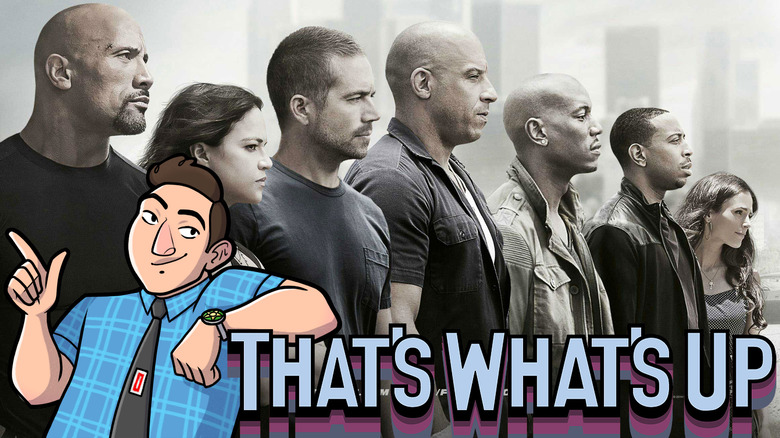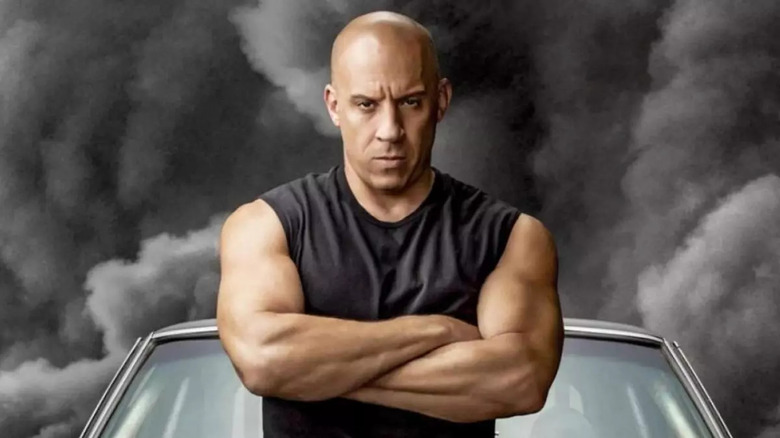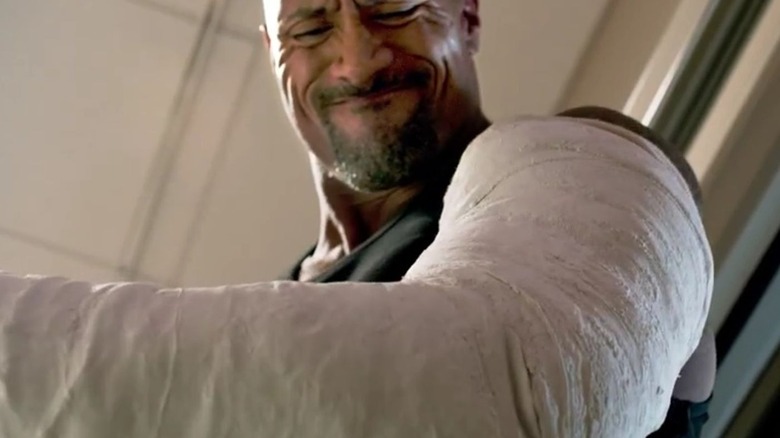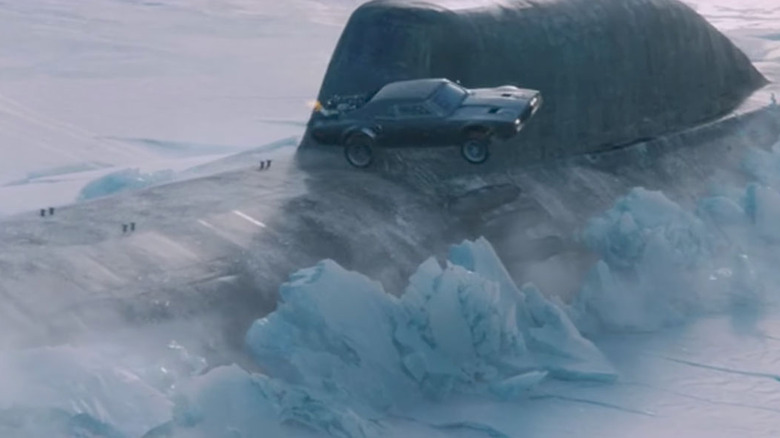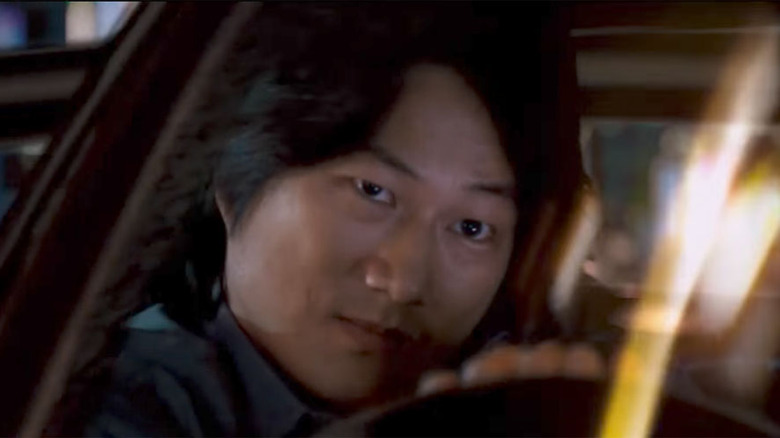That's What's Up: Why The Fast And Furious Movies Are The Best Modern Superhero Films
Each week, comic book writer Chris Sims answers the burning questions you have about the world of comics and pop culture: what's up with that? If you'd like to ask Chris a question, please send it to @theisb on Twitter with the hashtag #WhatsUpChris, or email it to staff@looper.com with the subject line "That's What's Up."
Q: Please elaborate on why the Fast and Furious movies are the best modern superhero films. — @cathaldon1
The important thing to establish this right up front is that when I say that the Fast and Furious movies are superhero films, I mean it in a very literal way. As my wife put it after we watched Furious 7 and saw Dom Toretto literally shatter a concrete parking garage by stomping on it like the Hulk, "this isn't a superhero movie in the way that Die Hard is a Christmas movie. This is a superhero movie in the way that The Avengers is a superhero movie."
And the more I thought about it, the more that made sense. It's not just the individual moments, although there are plenty of those that go well beyond the over-the-top bombast that you'd expect from an action movie franchise that's running eight sequels deep at this point and into the realm that's usually reserved for characters that left their parents on the dying planet Krypton. It's that they're built around the language of superheroes in every way.
Everyone has super-powers
Of course, the easiest— and probably most compelling—argument is that everyone in these movies has straight up super-powers.
It's something that I really first noticed back in Fast Five, when there's a moment where Toretto (Vin Diesel) is handcuffed by his enemies. As soon as they leave the room, he effortlessly snaps the handcuffs and then just goes on about his day, and no one ever mentions this at all. No one even goes "hey, have you noticed that Dom is, like, as strong as Spider-Man?" It's just accepted as a normal part of life for these people who, four movies before this, were involved in some mildly exciting street racing. You'd think it would bear mentioning, but no.
And again, that's not the only time something like this happens. By the time we get into Fate of the Furious and the part where Luke Hobbs (Dwayne "The Rock" Johnson) and Deckard Shaw (Jason Statham) are sentenced to an "Ultramax" prison—one step beyond a Supermax, just in case things weren't quite superheroic enough—things have gotten to the point of being functionally indistinguishable from, like, DragonBall Z. Not only does Hobbs tear a concrete table out of the wall and use it for bicep curls, there's a part where he's shot at point-blank range from a shotgun three times, and his only response is to tell the person shooting him that rubber bullets were a big mistake.
The only thing separating that scene from Superman slugging it out with Doomsday is that nobody in Fast and Furious has heat vision. Yet.
Seriously: everyone has super-powers
Admittedly, there's a certain level of strength and toughness that you have to expect from the main characters of an action movie. If you were feeling especially argumentative, you could even argue that the damage that the F&F characters suffer is no more over the top than what you'd see in a Jackie Chan movie, and he's a guy who's supposed to be the kind of relatable everyman that serves as a direct contrast to the unstoppable supermen you usually see in action movies. The only real difference, you may well be saying to yourself, is how cocky they are about shrugging it off.
It's a fair argument, but it ignores the fact that these are characters who routinely display a level of power that's far beyond that of mortal men. Consider, for instance, the Rock's arc in Furious 7: at the start of the movie, he has a fistfight with Jason Statham, who's so deadly that he singlehandedly left an entire hospital and a squadron of soldiers in ruins, at the end of which he's blown out a window with a hand grenade and crashes two stories into a car that collapses under his weight. After that, he goes to the hospital—literally the most vulnerable we have ever seen an F&F character—but when he sees that the movie's villain is sending drones and assault helicopters through the streets in an effort to kill his friends, something amazing happens.
He stands up out of his hospital bed, flexes so hard that the cast on his arm shatters, and tells his daughter "Daddy's gotta go to work." Then he steals an ambulence, crashes it off an overpass into a drone, kicks his way through a windshield, picks up a minigun from the wreckage, and shoots down a helicopter.
Two things: first, nothing about that is something a normal human being is even remotely capable of. Second, and this is absolutely true, when I saw that in the theater I got so excited that I took my shirt off and waved it around my head like a helicopter.
The Fast and Furious universe is basically sci-fi
It's not just about the characters themselves and the things they can do. The nature of superhero comics, and the thing that's really captured by sprawling mass media franchises like the Marvel Cinematic Universe and DC's interconnected CW shows is that they exist within a superhero universe. They're built on the potential that inevitably comes from accepting the core premise: if you can believe that there's a good-natured alien who grew up in Kansas and gets super-powers from Earth's yellow sun, or that a brilliant industrialist can invent a flying suit of armor that's essentially a wearable Sherman tank, then what else is possible?
That's the same universe that's on display in the F&F universe. If we can believe that two people can slam into each other in a high-speed head-on collision and then get out and have a fight with gigantic wrenches, then the audience has to accept a whole heck of a lot more. And as the movies go on, we get it.
I talk about Furious 7 a lot because it's my favorite of the franchise, but it also marks the point where things are full-on superhero in a way that's impossible to go back from. The big threat in that movie is, after all, a bit of super-software called God's Eye that can tap into any surveillance system in the world, something that would be so dangerous in the wrong hands that a secret government agency has to recruit a team of indestructible heroes to recover it. That's the kind of plot you'd expect to see in a movie about Iron Man.
Fate of the Furious leans into the superhero stuff even harder. Not only is there a truly incredible sequence where the good guys have to fight an army of zombie cars—ZOMBIE CARS!—but there's a scene in that movie when the good guys are flying around on honest-to-God jet packs that bear a pretty uncanny resemblance to the Falcon's costume from the Captain America movies. Again, this is never explained, or even remarked on. It's just something we're meant to expect and accept by the nature of the universe.
The stakes are literally the fate of the world
The thing that makes the later entries in the F&F franchise (the Fastchise? Furiousverse?) so entertaining is the knowledge that they started with a movie that was basically just Point Break with all the surfing swapped out for tricked out cars and street racing. When people are flying around on jetpacks, or dropping out of airplanes to rescue the world's greatest hacker from a mercenary warlord who's capable of pulling off a drone strike in Los Angeles, there's one thought that keeps going through my head: These people are street racers.
Like, they're very good street racers, but it's not like they're going to James Bond school between movies. They just show up, have a conversation with Mr. Nobody—who is 100% just Nick Fury with two eyes—get the job done, and then celebrate with a cookout where someone talks a lot about the importance of family. It's honestly pretty delightful.
As the movies went on, that thought kept hitting harder. When Hobbs showed up as a commando working for the State Department who was tasked with bringing down a guy who was essentially wanted for illegally driving too fast, it was one thing. When the crew had to bring down a supervillain cyberterrorist named Cipher by driving cars so hard that it prevented global thermonuclear war, however, they were in full-on, literally saving-the-world territory. Like, that's literally what Superman is trying to prevent in Superman IV, and there's no possible way you can tell me that's more of a superhero movie than Fate of the Furious.
It's a pretty long way from a movie where they're very concerned with getting their hands on nitrous oxide so they can do a better job of stealing DVD players, and honestly: is there any wonder that after all that, the guy who writes those movies is always being asked when—not if, but when—they're going to wind up in outer space?
It has complicated continuity that includes retcons
For all that they're built on epic battles with incredible stakes, superhero stories aren't just about the things that happen. There's a structure to a superhero universe that has been developed from decades of adventure stories that are never actually meant to end, and when I say that the Fastchise speaks that language, I mean it. And it all comes from continuity.
The weirdest part of the entire saga—even weirder than the jetpacks, a-bombs, and the crew essentially street racing a decommissioned Soviet nuclear submarine—is definitely the third installment, Tokyo Drift. It's a little side story that's barely connected to the movies that came before it or the ones that came after. It's set on the other side of the world from the first two, and aside from a brief cameo from Vin Diesel at the end, the only character that connects it is Han Seoul-Oh (Sung Kang), and that dude dies in it.
The thing is, when the movies returned to their main storyline in the fourth movie, Fast & Furious, Han returned, too, with no mention of the fact that he'd been killed off in the previous movie. It wasn't until the two storylines were finally reconciled at the end of Fast & Furious 6 that Han's death was canonical, and for the seven years between those movies, there was an honest question about how the Furious Canon was meant to work. Was Tokyo Drift a hoax, a dream, an imaginary story? Was it meant to be set in the future? Were F&F 4, 5, and 6 technically prequels?
That's not the kind of question you usually see in movies, but it's definitely the kind of debate that happens all the time with superhero comics.
Characters die and come back to life
Han isn't the only character to make a mysterious return from the dead, either. In Fast & Furious, Letty Ortiz (Michelle Rodriguez) is murdered while working undercover to bring down an international drug dealer. In the next movie, however, it's revealed that she's actually still alive, but suffering from amnesia that has robbed her of her memory of Dom, including their secret marriage.
On the off chance that sentence wasn't enough all by itself to draw a pretty direct comparison to the X-Men, consider this: Letty's not the only character to experience a miraculous resurrection. Hell, she's not the only one in that particular movie. After driving a car off a ramp created by a collapsing parking garage and into the helicopter of that mercenary warlord I mentioned earlier, Dom Toretto himself is literally brought back to life with the power of love.
If you haven't watched the movie (and if that's the case, what are you even doing with your life), that probably sounds like an exaggeration. I assure you that it is not. Dom dies, and the shock of seeing his body in a pile of rubble that looks for all the world like a conscious attempt to recreate the climactic splash page from The Death of Superman gives Letty her memories back, and then she wills him back to life. It's amazing.
The true modern mythology
There's more, too. We could talk about how each member of the team has their own specialty that they're almost supernaturally good at, like how Tej is skilled enough to hack any computer they run across, or how Dom can build an undetectable tracking device in his dining room like Batman, or how Roman...well, I'm not exactly sure what Roman's good at, but I'm sure there's something in one of those movies somewhere. They are, by any measure you can think of, a superhero team. The only thing they're missing is capes.
They even follow the pattern of fighting and then teaming up with their adversaries. Hobbs, the Shaw Brothers, and even Brian O'Connor himself all started as Dom's adversaries before coming around and joining up with his crew. That's a pattern you can see in superhero media that you almost never see in movies, partly because the F&F saga isn't built on the rules that we usually see from movies—with eight films out and at least two more planned, it's beyond that. It's an ongoing, sequential adventure story, and the rules for those were defined by superhero stories even before you get into the kind of escalation that leads to bulletproof characters and cars fighting submarines.
At the end of the day, that's what it comes down to: these are movies that feel like superhero stories, with all the epic stakes and ridiculous realities that come with them. It's why they work so well as they get bigger and bolder, and why I sincerely hope they stay on the path that led them from street racing to elaborate heists and all the way down to somehow becoming the government's go-to counter-terrorist strike force.
The only thing that would make it better is if the next movie has a post-credits sequence where Hobbs hands Dom a file and he turns directly to the camera to tell the audience "Oh, I forgot to tell you... vampires are real" to lead into a crossover with Blade or something. And honestly, would any of us be surprised at all if that actually happened?
Each week, comic book writer Chris Sims answers the burning questions you have about the world of comics and pop culture: what's up with that? If you'd like to ask Chris a question, please send it to @theisb on Twitter with the hashtag #WhatsUpChris, or email it to staff@looper.com with the subject line "That's What's Up."
